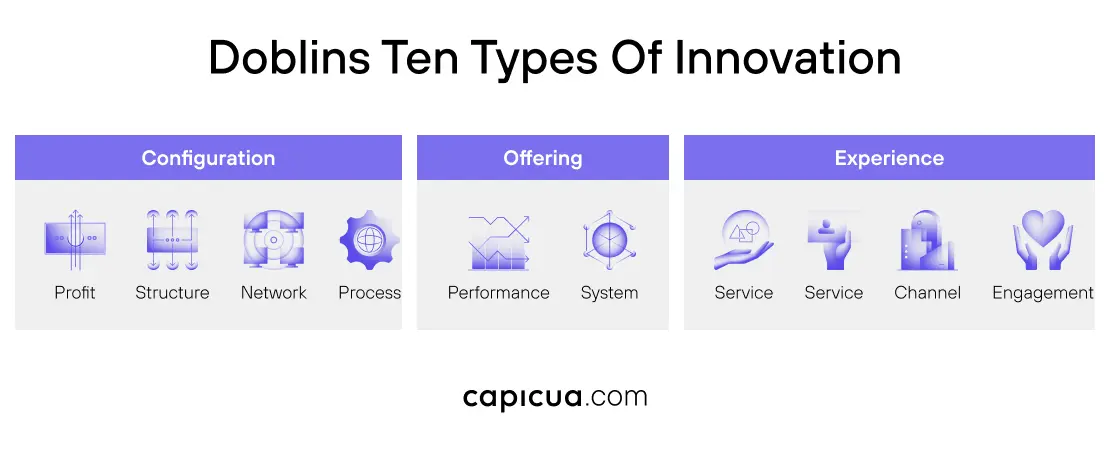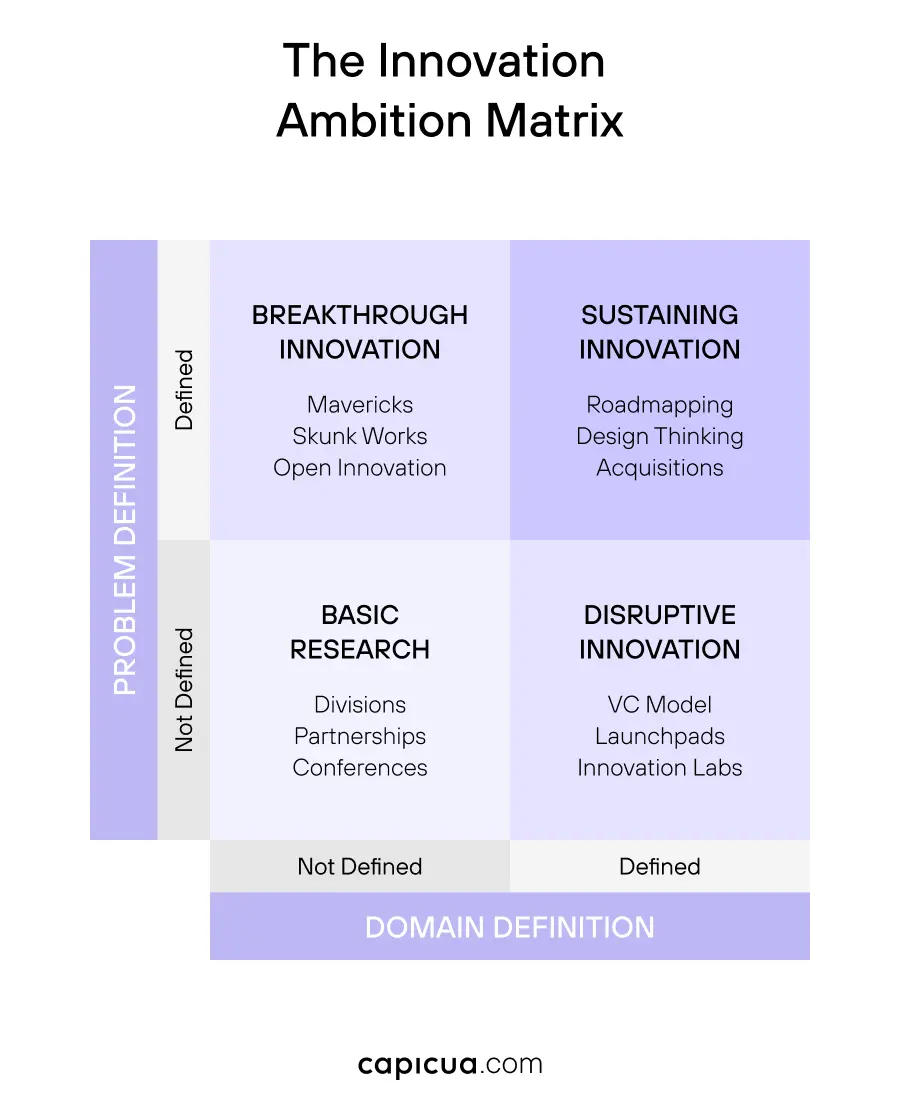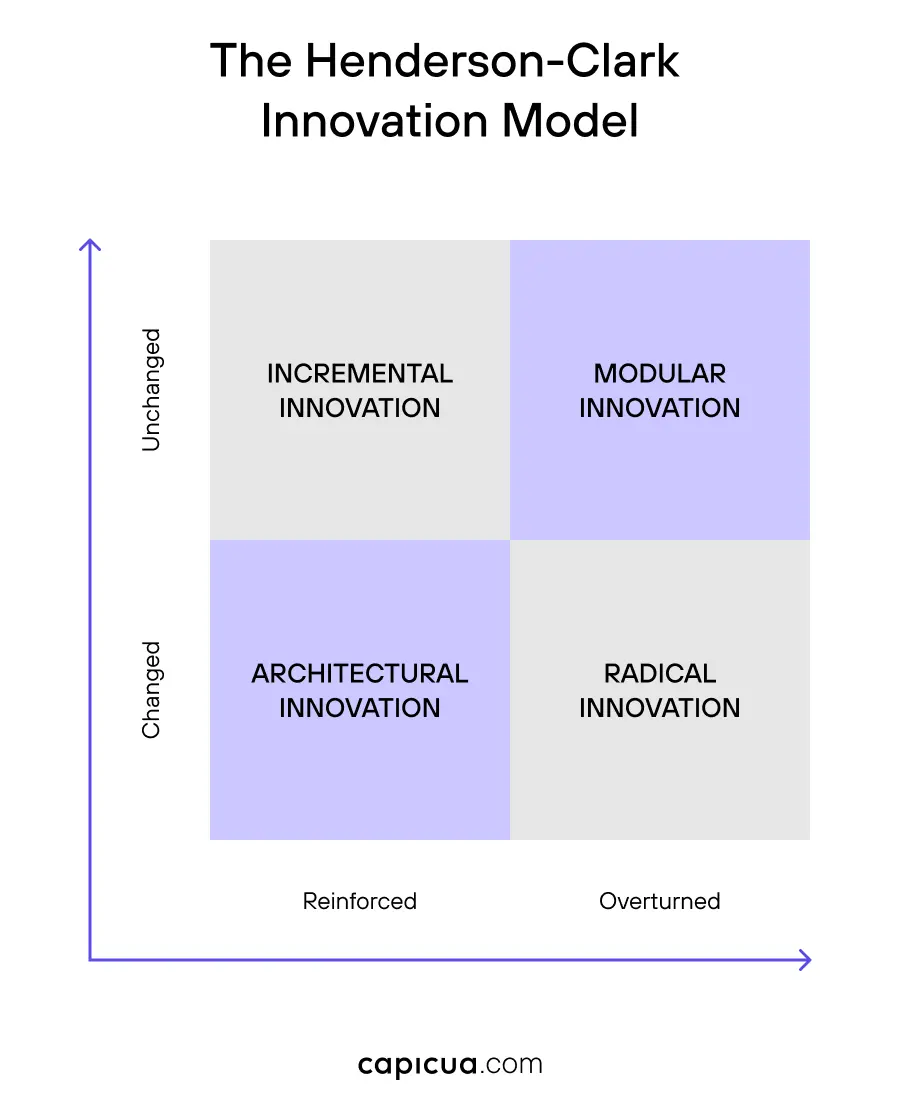Innovation is often thought of as a single person having a sudden idea.
Lasting success rarely happens alone but as the result of a dedicated innovation system.
The way different kinds of innovation systems are structured influences whether they yield small enhancements or industry-changing evolution.
In this article, we'll break down the kinds of innovation systems and why leaders and founders should pay attention to them.
What is Innovation?
While often used lightly, "innovation" can be a surprisingly difficult term to pin down.
And rather than a single item, it encompasses a spectrum of edges.
As Peter Drucker famously said, "The best way to predict the future is to create it.".
That's the essence of innovation, the engine that moves beyond "what is" to "what could be."
In this context, business innovation can range from product updates to new market categories.
But what are the types of innovation, and what purpose does each serve?
The 5 Different Kinds of Innovation
1. Disruptive Innovation
Popularized by Clayton Christensen, disruptive innovation focuses on creating new markets in parallel with current operations.
At its core, this approach tends to operate independently of the core business.
The goal here is to protect the parent company's core processes and profit formulas.
These operations have autonomous, skunkworks teams, focused on "good enough" technologies to enter new markets.
Think of the Amazon Echo. It created a new market for voice-activated home assistants without compromising Amazon's operations.
2. Incremental Innovation
Also called continuous improvement, incremental innovation improves an existing product or service to tackle transformation challenges.
For mature companies, this system is essential for defending market share and satisfying evolving user demands.
There are several examples of incremental innovation in our daily lives! Think of new Coca-Cola flavors or TVs with brighter screens.
Rather than introducing completely new products, companies leverage these improvements or additions to stay competitive.
3. Adjacent Innovation
The focus of adjacent innovation is for companies to expand into areas closely related to their current products or markets.
By building on solid grounds, companies can create new offerings or enter nearby markets with minimal risk.
With adjacent innovation, companies can explore ecosystems to identify and acquire existing technologies for their portfolio.
Examples include the Netflix expansion from DVDs to streaming and Starbucks starting to sell its coffee in grocery stores.
4. Radical Innovation
In radical innovation, companies present products or services that revolutionize existing markets.
Likewise, this offering can create entirely new markets with unprecedented value.
This innovation disrupted (and continues to disrupt) multiple industries, including the phone and camera markets.
Most things we interact with today were radical innovations, from the first iPhone and electric cars to the internet itself.
Its applications include CRISPR, which selectively modifies DNA, and MRI machines, which use electromagnetic forces rather than X-rays.
5. Model Innovation
Lastly, business innovation models don't rethink products but how to create them.
This innovation type can encompass rewriting the value proposition or redefining overall revenue models.
Business model rethinking also enables technological service innovation, enabling services to be delivered in entirely new ways.
Examples of business innovation include platform-based models like Amazon and Airbnb, as well as freemium models like Spotify.
What is an Innovation System?
An innovation system is the framework that guides value from random ideas to structured outcomes.
A common mistake is to focus only on outputs without appreciating the background.
That's why innovative systems include specific cultural rules and funding processes.
With a solid innovation system, companies can reach a continuous flow of valuable new offerings aligned with strategic goals.
Different Kinds of Innovation Systems
1. Doblin's Ten-Types Framework
This system reveals that, rather than single big ideas, innovation comes from multiple dimensions working together.
The Ten-Types Framework recognizes that successful innovation combines several types.
In it, Doblin categorizes innovation into ten distinct types across three areas:
- Configuration. Company's internal engine: profit models, network connections, organizational structure and core processes.
- Offering. The actual products: both their performance and how they work together as a system.
- Experience. Customer interactions: your service delivery, sales channels, brand expression and customer engagement.
For example, Netflix didn't just make its product better: it changed its profit model and delivery channel.
Beyond moving from DVDs to streaming, it evolved from rental to subscription and from physical stores to online access.
2. Innovation Ambition Matrix
This innovation framework focuses on answering the crucial question of: "How much should we bet on each innovation project?"
To answer it, it creates three innovation strategy zones for companies and their market.
- Core Innovation to optimize existing products for current customers.
- Adjacent Innovation to expand your business into new markets or with new techs.
- Transformational Innovations to create breakthrough offerings that define new categories.
According to Google's Model for Innovation, companies should leverage a 70/20/10 innovation investment model.
Here, 70% go to core innovations, 20% to adjacent innovations and 10% to transformational innovations.
This process ensures improving today's business while building tomorrow's.
3. Henderson-Clark Model
Developed by Rebecca Henderson and Kim Clark, this framework explains why some "simple" innovations have a big impact.
This model is also known for explaining how companies can master existing technology but still miss major shifts.
At its core, this model analyzes changes along two dimensions: fundamental elements and overarching design.
- Incremental Innovation gradually improves both components and architecture.
- Modular Innovation radically changes components while keeping the same architecture.
- Architectural Innovation reconfigures existing components into new systems.
- Radical Innovation transforms both components and their relationships.
This system is particularly valuable for understanding how minor changes can revolutionize entire product categories.
Components of Innovation Systems
1. Vision
It's not enough to simply "want to innovate". A robust system requires a clear strategic direction, clear boundaries and alignment with broader objectives.
This edge answers the critical "why" and "where" of innovation, from entering new markets to transforming User Experiences.
2. Methodology
As you may assume, innovation is more than brainstorming ideas.
Different kinds of innovation demand a clear pathway for idea selection, testing and scaling.
An innovation methodology is the engine that moves ideas from conception to impact.
This edge establishes a formal pipeline with decision-making stage gates.
It includes clear success metrics and considerations, such as agile methodologies and rapid prototyping.
3. Culture
Even the most advanced theoretical system can fail without the human elements.
That's why all kinds of innovation system encourage calculated risk-taking and curiosity.
Fostering a strong company culture empowers leaders and frontline employees alike to experiment and even fail.
This aspect includes cross-functional teams, ongoing training and strong communication channels.
Why Founders Leverage Innovation Systems?
To summarize, innovation systems transform random breakthroughs into actual, reliable growth.
If missing, companies can end up wasting resources on scattered projects that fail to align with users or goals.
Known systems, designed for efficiency, can improve current products.
However, it may limit new ideas that could change the industry.
Conversely, a system designed for radical exploration may struggle to deliver the steady improvements that a core business needs.
Choosing a weak system is like trying to win an F1 race with a garbage truck.
Both are useful vehicles, but they are engineered for completely different purposes.
That's why there's no universal approach for different kinds of innovation.
Each company, product and goal requires a tailored approach.
Conclusion
Innovation systems are flexible toolkits, not structured, one-size-fits-all guides.
That's why successful companies and visionary leaders learn to leverage multiple frameworks depending on goals.
Rather than random ideas, organized systems make innovation go from a risky bet into a reliable way to grow.
At Capicua, we built Shaped Clarity™ to eliminate uncertainty and deliver compounded innovation.
We're a Product Growth and Evolution Partner; reach out today to boost innovation!
















